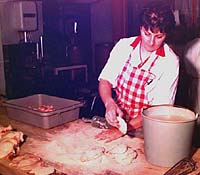|
|

|

|

|
As in cattle's division between dairy and beef production, poultry is also divided into two distinct, efficient, and productive industries; meat production and egg production. Broiler and roaster producers grow birds for meat. Egg producers produce eggs for retail sale (market egg producers) or for sale to hatcheries that sell day-old chicks to market egg or broiler producers (hatcher egg producers). The structure of the turkey industry is very much the same as the broiler industry, yet much smaller in scale.
As North American grain production evolved into a large scale, intensive industry, poultry production changed from a backyard, low intensity farming practice to a large scale intensive industry based on the now-available concentrate feeds. Most Saskatchewan producers use this intensive approach, raising all types of poultry in large, automated, controlled environment barns that can optimize growth rates, meat quality, and therefore maximize the economics of poultry production.
|

Today, there are in excess of 13.3 million chickens raised for meat, and 900 000 chickens which produce eggs. The total production for Canada includes more than 21 million laying hens supplying 470 million dozen eggs and in excess of 400 million kilograms of meat. The growing popularity of lean meat alternatives to beef, including chicken and turkey, have been responsible for tremendous growth in the poultry industry. Intensively managed poultry operations have also been responsible for the growth of associated industries which have provided specialize housing and equipment for processing, chemicals including disinfectants, pharmaceuticals, antibiotics, vaccines, and feed additives.
|
|
|
|
|
